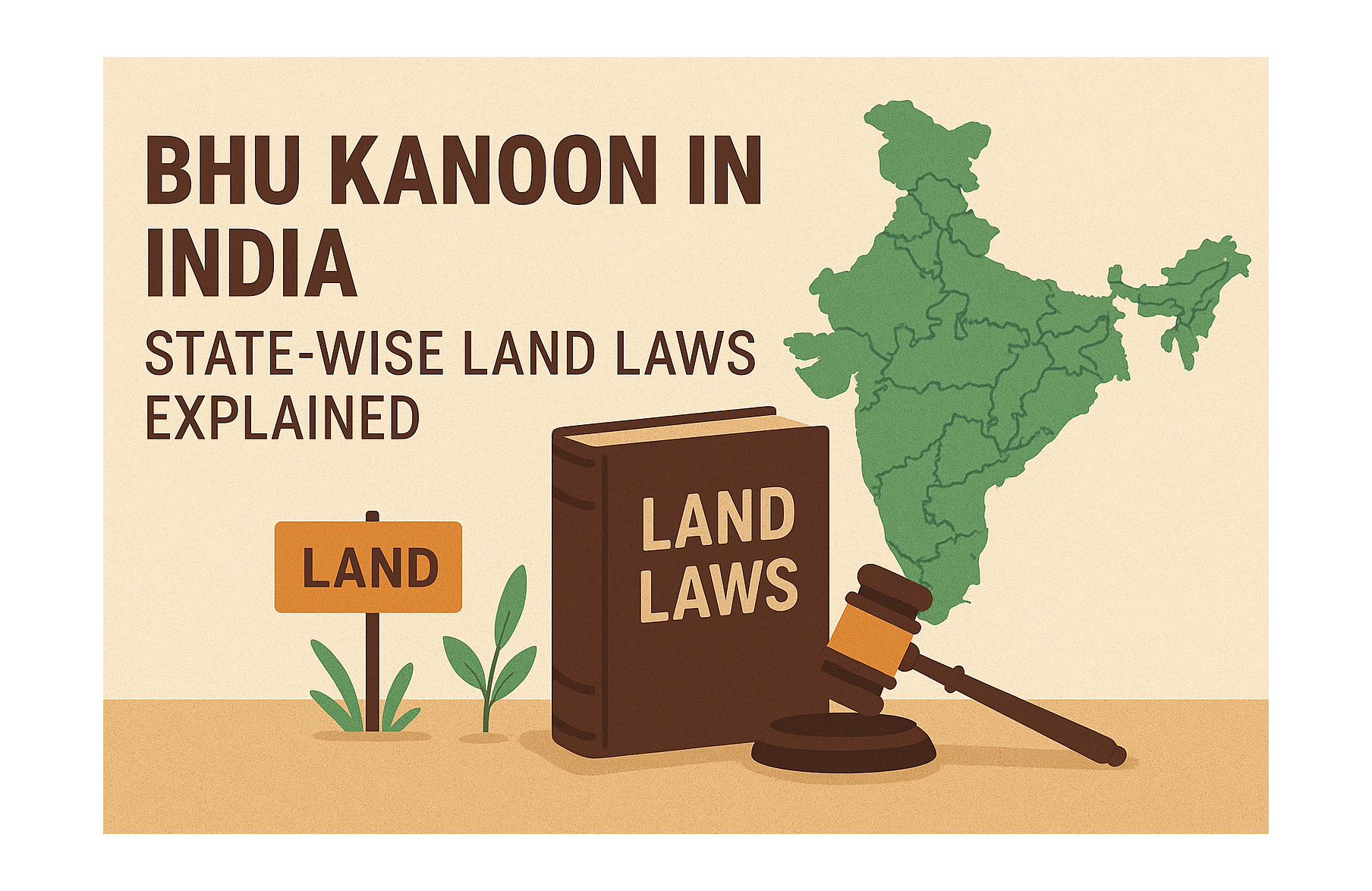 Blog
Blog
Introduction
Land is not just property in India—it represents livelihood, identity, and heritage. To safeguard these aspects, every state has framed its own set of land laws, commonly known as Bhu Kanoon. Since land is a State subject under the Indian Constitution, each state decides how land can be owned, transferred, and used. Alongside central laws such as RERA (2016), the Transfer of Property Act (1882), and the Registration Act (1908), states have unique regulations that reflect their geography, economy, and local needs.
Why Bhu Kanoon Exists
- To protect farmers, tribals, and locals from exploitation or displacement.
- To prevent land concentration in the hands of a few landlords or land mafia.
- To regulate tenancy and urban housing.
- To balance development with ecology, especially in hill and tribal states.
Central Laws That Apply Nationwide
While states create their own rules, some major central laws provide the framework:
- RERA (2016) – Brings transparency in real estate projects.
- Transfer of Property Act (1882) – Governs sale, lease, mortgage of property.
- Registration Act (1908) – Ensures property transactions are legally recorded.
- Benami Transactions (Prohibition) Act (1988, amended 2016) – Prevents illegal ownership.
- Land Acquisition, Rehabilitation & Resettlement Act (2013) – Ensures fair compensation for land acquired by government.
State-Wise Snapshots of Bhu Kanoon
Here’s a quick overview of land laws across India’s 28 states. Each state has its own specific acts and rules, shaped by its unique socio-economic realities:
- Andhra Pradesh – Land Reforms (Ceiling on Agricultural Holdings) Act (1973) limits holdings; tenancy rules protect cultivators.
- Arunachal Pradesh – Customary tribal laws prevent outsiders from owning land.
- Assam – Land & Revenue Regulation (1886) and Tenancy Act (1971) govern tenancy and tribal protections.
- Bihar – Bihar Tenancy Act (1885) and Land Reforms Act safeguard farmers; ceiling limits apply.
- Chhattisgarh – Similar to MP; strong tribal protections prevent exploitation.
- Goa – Goa Land Revenue Code (1968) and Tenancy Act regulate agricultural holdings and tenancy rights.
- Gujarat – Bombay Tenancy & Agricultural Lands Act applies; restrictions on transfer of tribal land.
- Himachal Pradesh – HP Tenancy and Land Reforms Act (1972) restricts outsiders from buying agricultural land without government approval.
- Jammu & Kashmir – Earlier outsiders couldn’t buy land; post-2019 reforms allow non-residents limited rights to purchase non-agricultural land.
- Jharkhand – Chotanagpur Tenancy (CNT) Act (1908) and Santhal Pargana Tenancy (SPT) Act (1949) protect tribal land from being sold to outsiders.
- Karnataka – Land Reforms Act (1961) and Rent Act (1999) govern tenancy; agricultural land restricted for non-farmers.
- Kerala – Land Reforms Act (1963) imposed ceilings; Paddy Land and Wetland Act (2008) prevents misuse of agricultural land.
- Madhya Pradesh – MP Land Revenue Code (1959) governs ownership and ceiling; tenancy protections for small farmers.
- Maharashtra – Maharashtra Ownership Flats Act (1963), Rent Control Act (1999), and MahaRERA protect buyers; advanced urban housing regulation.
- Manipur – Land Revenue and Reforms Act (1960) applies; tribal lands have additional protections.
- Meghalaya – Customary tribal laws dominate; outsiders restricted under Meghalaya Transfer of Land Regulation Act (1971).
- Mizoram – Land Revenue Act (2013) regulates land use, but most land is under customary ownership.
- Nagaland – Governed by Article 371A; land belongs to communities and tribes.
- Odisha – Odisha Land Reforms Act (1960) and land consolidation laws regulate holdings and redistribution.
- Punjab & Haryana – Punjab Land Revenue Act and tenancy laws govern agricultural land; strong urban development acts regulate housing.
- Rajasthan – Rajasthan Tenancy Act (1955) and Urban Improvement Act govern tenancy, ceilings, and planned development.
- Sikkim – Revenue Order No.1 (1917) restricts sale of land to non-Sikkimese.
- Tamil Nadu – Buildings (Lease and Rent Control) Act (1960) and Land Ceiling Act regulate tenancy and urban property.
- Telangana – Telangana Tenancy and Agricultural Lands Act (1950) and Dharani digital portal regulate land records.
- Tripura – Land Revenue and Reforms Act (1960) regulates holdings.
- Uttarakhand – Outsiders may purchase up to 2,500 sq.m. for residential purposes; protests demand stricter Bhu Kanoon.
- Uttar Pradesh – UP Zamindari Abolition and Land Reforms Act (1950) regulates agricultural holdings; UP-RERA ensures real estate transparency.
- West Bengal – Land Reforms Act (1955) and Premises Tenancy Act govern tenancy and agricultural land ceilings.
Recent Updates
- 2016 – RERA introduced; states set up their own RERA authorities.
- 2018 (Uttarakhand) – Outsider land purchase limit increased from 500 sq.m. to 2,500 sq.m.
- 2019 (J&K) – Article 370 revoked; new land laws allow outsiders limited rights.
- Ongoing – Digital land record initiatives (e.g., Bhulekh UP, Dharani Telangana, e-Dharti Delhi) improve transparency.
Why People Should Care
- Buyers – Avoid illegal deals by knowing outsider restrictions.
- Locals – Protect community land from exploitation.
- Investors – Understand state rules before investing.
- Policy makers – Balance development with protecting heritage and ecology.
Conclusion
Bhu Kanoon reflects the unique identity and needs of each Indian state. While central laws ensure a basic framework, state-specific regulations safeguard locals, preserve cultural identity, and balance development with sustainability. For anyone dealing with property—whether buying, selling, or investing—understanding these laws is not optional, it’s essential.
